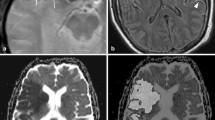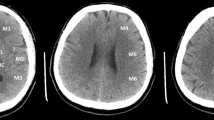Abstract
Introduction
Thrombolysis has been shown to improve neurological recovery in acute stroke. But the response to thrombolysis is variable across patients. We sought to investigate this variability by analyzing the lesion patterns following systemic thrombolysis with recombinant tissue plasminogen activator (rtPA) and tirofiban in middle cerebral artery (MCA) stroke.
Methods
One hundred three consecutive stroke patients (67 ± 14 years) were grouped according to the site of MCA occlusion and successful or failed recanalization as assessed with magnetic resonance angiography. Infarct lesions were analyzed in T2-weighted magnetic resonance images after 10 days.
Results
Patients recovered markedly upon successful recanalization following thrombolysis (p < 0.05) but remained severely impaired when there was no recanalization within 24 h. Infarct lesions were smaller after successful than after failed recanalization (p < 0.005). They occurred throughout the cerebral cortex on the cerebral convexity in distal MCA occlusions with large individual heterogeneity. In contrast, there was a large lesion overlap in insular cortex, basal ganglia, internal capsule, and paraventricular white matter in proximal MCA occlusions.
Conclusion
Systemic thrombolysis with rtPA and tirofiban of MCA occlusions resulted in early neurological recovery and preferentially peri-insular infarcts. In failed recanalization of the MCA stem there was a large lesion overlap in the hemispheric white matter and a lack of recovery.




Similar content being viewed by others
References
Hacke W, Kaste M, Bluhmki E, Brozman M, Davalos A, Guidetti D, Larrue V, Less KR, Medeghri Z, Schneider D, von Kummer R, Wahlgren N, Toni D (2008) Thrombolysis with alteplase 3 to 4.5 hours after acute ischemic stroke. N Engl J Med 359:1317–1329
Kidwell CS, Saver JL, Mattiello J, Starkman S, Vinuela F, Duckwiler G, Gobin YP, Jahn R, Vespa P, Kalafut M, Alger JR (2000) Thrombolytic reversal of acute human cerebral ischemic injury shown by diffusion/perfusion magnetic resonance imaging. Ann Neurol 47:462–469
Rother J, Schellinger PD, Gass A, Siebler M, Villringer A, Fiebach JB, Fiehler J, Jansen O, Kucinski T, Schoder V, Szabo K, Junge-Hulsing GJ, Hennerici M, Zeumer H, Sartor K, Weiller C, Hacke W, Kompetenznetzwerk Schlaganfall Study Group (2002) Effect of intravenous thrombolysis on MRI parameters and functional outcome in acute stroke <6 hours. Stroke 33:2438–2445
Kraemer N, Thomalla G, Soennichsen J, Fiehler J, Knab R, Kucinski T, Zeumer H, Röther J (2005) Magnetic resonance imaging and clinical pattern of patients with “spectacular shrinking deficit” after acute middle cerebral artery stroke. Cerebrovasc Dis 20:285–290
Singer OC, Du Mesnil De Rochemont R, Foerch C, Stengel A, Sitzer M, Lanfermann H, Neumann-Haefelin T (2004) Early functional recovery and the fate of the diffusion/perfusion mismatch in patients with proximal middle cerebral artery occlusion. Cerebrovasc Dis 17:13–20
Seitz RJ, Meisel S, Weller P, Junghans U, Wittsack H-J, Siebler M (2005) The initial ischemic event: PWI and ADC for stroke evolution. Radiology 237:1020–1028
Saqquar M, Molina CA, Salem A, Siddiqui M, Salem M, Uchino K, Calleja S, Garami Z, Khan K, Akhtar N, O’Rourke F, Shuaib A, Demchuk AM, Alexandrov AV (2007) Clinical deterioration after intravenous recombinant tissue plasminogen activator treatment: a multicenter transcranial Doppler study. Stroke 38:69–74
Choudhri TF, Hoh BL, Zerwes HG, Prestigiacomo CJ, Kim SC, Connolly ES Jr, Kottirsch G, Pinsky DJ (1998) Reduced microvascular thrombosis and improved outcome in acute murine stroke by inhibiting GP IIb/IIIa receptor-mediated platelet aggregation. J Clin Invest 102:1301–1310
Abumiya T, Fitridge R, Mazur C, Copeland BR, Koziol JA, Tschopp JF, Pierschbacher MD, del Zoppo GJ (2000) Integrin alpha(IIb) beta(3) inhibitor preserves microvascular patency in experimental acute focal cerebral ischemia. Stroke 31:1402–1409
Seitz RJ, Hamzavi M, Junghans U, Ringleb PA, Schranz C, Siebler M (2003) Thrombolysis with recombinant tissue plasminogen activator and tirofiban in stroke. Preliminary observations. Stroke 34:1932–1935
Seitz RJ, Meisel S, Moll M, Wittsack H-J, Junghans U, Siebler M (2004) The effect of combined thrombolysis with rtPA and tirofiban on ischemic brain lesions. Neurology 62:2110–2112
Straub S, Junghans U, Jovanovic V, Wittsack HJ, Seitz RJ, Siebler M (2004) Systemic thrombolysis with recombinant tissue plasminogen activator and tirofiban in acute middle cerebral artery occlusion. Stroke 35:705–709
Pancioli AM, Broderick J, Brott T, Tomsick T, Khoury J, Bean J, del Zoppo G, Kleindorfer D, Woo D, Khatri P, Castaldo J, Frey J, Gebel J Jr, Kasner S, Kidwell C, Kwiatkowski T, Libman R, Mackenzie R, Scott P, Starkman S, Thurman RJ (2008) The combined approach to lysis utilizing eptifibatide and rt-PA in acute ischemic stroke: the CLEAR stroke trial. Stroke 39(12):3268–3276
Beaulieu C, de Crespigny A, Tong DC, Moseley ME, Albers GW, Marks MP (1999) Longitudinal magnetic resonance imaging study of perfusion and diffusion in stroke: evolution of lesion volume and correlation with clinical outcome. Ann Neurol 46:568–578
Schwamm LH, Koroshetz WJ, Sorensen AG, Wang B, Copen WA, Budzik R, Rordorf G, Buonanno FS, Schaefer PW, Gonzalez RG (1998) Time course of lesion development in patients with acute stroke. Stroke 29:2268–2276
Binkofski F, Seitz RJ, Hackländer T, Pawelec D, Mau J, Freund H-J (2001) The recovery of motor functions following hemiparetic stroke: a clinical and MR-morphometric study. Cerebrovasc Dis 11:273–281
Wittsack HJ, Ritzl A, Fink GR, Wenserski F, Siebler M, Seitz RJ, Modder U, Freund HJ (2002) MR imaging in acute stroke: diffusion-weighted and perfusion imaging parameters for predicting infarct size. Radiology 222:397–403
Brott T, Adams HP Jr, Olinger CP, Marler JR, Barsan WG, Biller J, Spilker J, Holleran R, Eberle R, Hertzberg V (1989) Measurements of acute cerebral infarction: a clinical examination scale. Stroke 20:864–870
van Swieten JC, Koudstaal PJ, Visser MC, Schouten HJ, van Gijn J (1988) Interobserver agreement for the assessment of handicap in stroke patients. Stroke 19:604–607
Seitz RJ, Höflich P, Binkofski F, Tellmann L, Herzog H, Freund H-J (1998) Role of the premotor cortex for recovery from middle cerebral artery infarction. Arch Neurol 55:1081–1088
Talairach J, Tournoux P (1988) Co-planar stereotaxic atlas of the human brain. Thieme, New York
Olivot JM, Mlynash M, Thijs VN, Kemp S, Lansberg MG, Wechsler L, Schlaug G, Bammer R, Marks MP, Albers GW (2008) Relationships between infarct growth, clinical outcome, and early recanalization in diffusion and perfusion imaging for understanding stroke evolution (DEFUSE). Stroke 39:2257–2263
De Silva DA, Fink JN; Christensen S, Ebinger M, Bladin C, Levi CR, Parsons M, Butcher K, Barber PA, Donnan GA, Davis SM (2009) Assessing reperfusion and recanalization as markers of clinical outcomes after intravenous thrombolysis in the echoplanar imaging thrombolytic evaluation trial (EPITHET). Stroke (in press)
Saqqur M, Tsivgoulis G, Molina CA, Demchuk AM, Shuaib A, Alexandrov AV, CLOTBUST investigators (2009) Residual flow at the site of intracranial occlusion on transcranial Doppler predicts response to intravenous thrombolysis: a multi-center study. Cerebrovasc Dis 27:5–12
Fink JN, Selim MH, Kumar S, Voetsch B, Fong WC, Caplan LR (2005) Insular cortex infarction in acute middle cerebral artery territory stroke. Arch Neurol 62:1081–1085
Phan TG, Donnan GA, Wright PM, Reutens DC (2005) A digital map of middle cerebral artery infarcts associated with middle cerebral artery trunk and branch occlusion. Stroke 36:986–991
Stoeckel MC, Meisel S, Wittsack HJ, Seitz RJ (2007) Pattern of cortex and white matter involvement in severe middle cerebral artery ischemia. J Neuroimag 17:131–140
Falcao AL, Reutens DC, Markus R, Koga M, Read SJ, Tochon-Danguy H, Sachinidis J, Howells DW, Donnan GA (2004) The resistance to ischemia of white and gray matter after stroke. Ann Neurol 56:695–701
Bang OY, Saver JL, Buck BH, Alger JR, Starkman S, Ovbiagele B, Kim D, Jahan R, Duckwiler GR, Yoon SR, Vinuela F, Liebeskind DS (2008) Impact of collateral flow on tissue fate in acute ischaemic stroke. J Neurol Neurosurg Psychiatr 79:625–629
Bang OY, Lee PH, Heo KG, Joo US, Yoon SR, Kim SY (2005) Specific DWI lesion patterns predict prognosis after acute ischemic stroke within the MCA territory. J Neurol Neurosurg Psychiatry 76:1222–1228
Karnath HO, Fruhmann Berger M, Kuker W, Rorden C (2004) The anatomy of spatial neglect based on voxelwise statistical analysis: a study of 140 patients. Cereb Cortex 14:1164–1172
Schaechter JD, Fricker ZP, Perdue KL, Helmer KG, Vangel MG, Greve DN, Makris N (2009) Microstructural status of ipsilesional and contralesional corticospinal tract correlates with motor skill in chronic stroke patients. Human Brain Mapp (in press)
Giele JLP, Witkamp TD, Mali WPTM, van der Graaf Y (2004) Silent brain infarcts in patients with manifest vascular disease. Stroke 35:742–746
O’Sullivan M, Morris RG, Huckstep B, Jones DK, Williams SCR, Markus HS (2004) Diffusion tensor MRI correlates with executive dysfunction in patients with ischemic leukoaraiosis. J Neurol Neurosurg Psychiatry 75:441–447
Kim YS, Garami Z, Mikulik R, Molina CA, Alexandrov AV (2005) Early recanalization rates and clinical outcomes in patients with tandem internal carotid/middle cerebral artery occlusion and isololated middle cerebral artery occlusion. Stroke 36:869–871
Wunderlich MT, Goertler M, Postert T, Schmitt E, Seidel G, Gahn G, Samii C, Stolz E (2007) Recanalization after intravenous thrombolysis: does a recanalization time window exist? Neurology 68:1364–1368
Fiehler J, Knudson K, Thomalla G, Goebell E, Rosenkranz M, Weiller C, Rother J, Zeumer H, Kucinski T (2005) Vascular occlusion sites determine differences in lesion growth from early apparent diffusion coefficient lesion to final infarct. Am J Neuroradiol 26:1056–1061
Derex L, Hermier M, Adeleine P, Pialat JB, Wiart M, Berthezène Y, Froment JC, Trouillas P, Nighoghossian N (2004) Influence of the site of arterial occlusion on multiple baseline hemodynamic MRI parameters and post-thrombolytic recanalization in acute stroke. Neuroradiology 46:883–887
Gadda D, Vannucchi L, Niccolai F, Neri AT, Carmigani L, Pacini P (2005) Multidetector computed tomography of the head in acute stroke: predictive value of different patterns of dense artery sign revealed by maximum intensity projection reformations for location and extent of the infracted area. Eur Radiol 15:2387–2395
Ruberia M, Ribo M, Delgado-Mederos R, Santamarina E, Delgado P, Montaner J, Alvarez-Sabín J, Molina CA (2006) Tandem internal carotid artery/middle cerebral artery occlusion. An independent predictor of poor outcome after systemic thrombolysis. Stroke 37:2301–2305
Seitz RJ, Siebler M (2008) Platelet GPIIb/IIIa receptor antagonists in human ischemic brain disease. Curr Vasc Pharmacol 6:29–36
Acknowledgement and funding
The study was supported by the Competence Net Stroke of the BMBF. The authors thank Erika Rädisch for skillful assistance during MR-Scanning.
Conflict of interest statement
We declare that we have no conflict of interest.
Author information
Authors and Affiliations
Corresponding author
Rights and permissions
About this article
Cite this article
Seitz, R.J., Sondermann, V., Wittsack, HJ. et al. Lesion patterns in successful and failed thrombolysis in middle cerebral artery stroke. Neuroradiology 51, 865–871 (2009). https://doi.org/10.1007/s00234-009-0576-x
Received:
Accepted:
Published:
Issue Date:
DOI: https://doi.org/10.1007/s00234-009-0576-x




